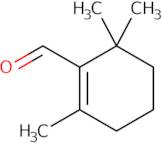b-Cyclocitral
CAS: 432-25-7
Ref. 3D-FC02703
| 1g | Descontinuado | ||
| 2g | Descontinuado | ||
| 5g | Descontinuado | ||
| 10g | Descontinuado | ||
| 25g | Descontinuado | ||
| 250mg | Descontinuado | ||
| 500mg | Descontinuado |
Informação sobre produto
- 1-Cyclohexene-1-carboxaldehyde, 2,6,6-trimethyl-
- 1-Formyl-2,6,6-trimethyl-1-cyclohexene
- 2,6,6-Trimethyl-1-cyclohexen-1-carboxaldehyde
- 2,6,6-Trimethyl-1-cyclohexene-1-carboxaldehyde
- 2,6,6-Trimethyl-1-cyclohexenecarboxaldehyde
- 2,6,6-Trimethylcyclohex-1-Ene-1-Carbaldehyde
- 2,6,6-Trimethylcyclohexene-1-carbaldehyde
- Ai3-37227
- FEMA No. 3639
- β-Cyclocitral
- Ver mais sinónimos
b-Cyclocitral is a monoterpene that has been shown to have antifungal activity against Cryptococcus neoformans. It also inhibits the growth of cyanobacterial strains and causes cell lysis. The b-cyclocitral precursor, ethyl decanoate, is a major component of carotenoid pigments in some freshwater fish such as catfish and malic acid is a key metabolite of b-cyclocitral. The reaction products of b-cyclocitral with sodium carbonate were investigated using a gas chromatography-mass spectrometry (GCMS) technique. Kinetic studies on the reaction between b-cyclocitral and sodium carbonate showed an initial rate for the reaction at about 0.4 M/sec, which decreased over time to about 0.1 M/sec after 1 hour. Chronic bronchitis has been shown to be caused by inflammation in the airways, which can be





